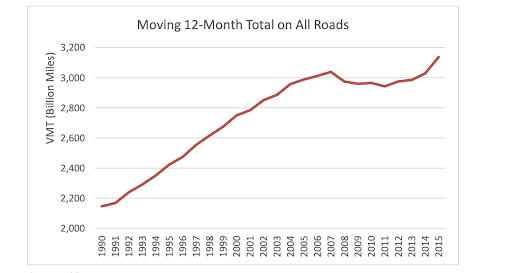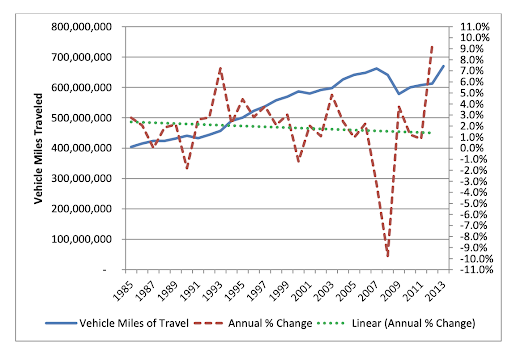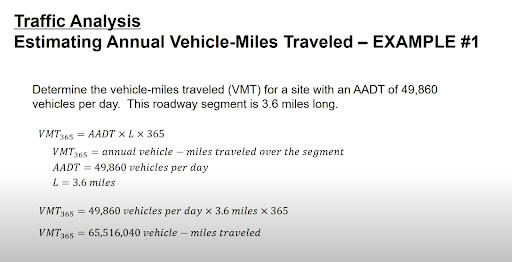What Is Vehicle Miles Traveled (VMT)?
Vehicle Miles Traveled (VMT) is an essential traffic metric that calculates vehicle travel within a certain area. In this blog, we cover the uses of VMT (there are many), how to calculate the metric, and how tracking VMT is a critical component in reducing it.
What is VMT?
VMT is a widely used and significant measurement in the world of traffic engineering. As the name implies, Vehicle Miles Traveled refers to the total number of miles traveled by a motor vehicle in a region over a certain period of time, usually over a year. When officials measure the VMT of an area such as a neighborhood, city or state, they are measuring the total amount of miles traveled by all vehicles.
It’s possible to calculate VMT for a single vehicle if you are trying to figure out how much that vehicle is getting driven over a period of time. However, VMT does not take into account the number of passengers inside. For example, a vehicle with five passengers and a vehicle with one passenger traveling 4,000 miles each year both have VMT of 4,000.
Uses and applications
VMT has many different applications. For starters, it’s the leading way to measure demand for both personal and commercial vehicle travel. How busy is an area? Knowing how much need there is influences infrastructure investment and policy decisions such as speed limits. As mentioned earlier, vehicle miles traveled is key in transportation planning as it helps illuminate trends. Is travel booming in one area? Is it declining in another? What are the predictions for future congestion levels? For example, if the projection is high, planners can look into more public transportation options to help alleviate it.
VMT helps planners and governments keep a pulse on vehicle transportation in their communities. It also serves as a useful tool to help them react to the changes. If one area has VMT that is steadily climbing at a faster rate over time, they can infer more people are moving there and therefore plan to build infrastructure to keep up with the growing demand.
Additionally, tracking VMT can help governments understand the impact of transportation on air quality and greenhouse gas emissions in different areas which can inform efforts to reduce pollution.

Vehicle Miles Traveled increasing from 1990-2015
Texas A&M Transportation Institute
Turning data into action
As regions densify and populations increase it’s inevitable that vehicle miles will rise as well, along with congestion and greenhouse gas emissions. While building more lanes and bigger roads is one solution, the better long-term fix (see the law of induced demand) that also addresses environmental concerns is to get people to drive less. The question for city planners and traffic engineers then becomes, how do we get people out of their cars?
To answer that, they need to know the starting point. How much are people driving? At what rate is the VMT increasing, and where is it increasing fastest? Knowing all of that is essential. How else would they be able to track results or changes without first knowing where they stand? Once they have that information in the form of VMT, they can implement solutions. For example, public transportation options or infrastructure that facilitates other modes of transport such as bike lanes. After implementing solutions, tracking VMT helps quantify how successful or unsuccessful the solutions have been at lowering it.

Annual change in Vehicle Miles Traveled over time
Texas A&M Transportation Institute
LOS vs VMT
By this point in the blog, you’re familiar with what VMT is, but it’s also necessary to understand Level of Service (LOS). Why, you might ask? Before VMT was implemented as the federally mandated metric to quantify congestion, the standard was LOS.
The difference is LOS is used to symbolize the quality of traffic services based on performance measures like speed, density, delay, etc. The whole point of LOS and measuring it is to keep track of and ensure a safe and reliable transportation network that is meeting demand.
VMT on the other hand measures the total amount of miles traveled by motor vehicles in a region over a time period. It’s less about the quality of service provided by a road segment and more about measuring how much a roadway is used over time. Under VMT it is easier to account for environmental factors like increasing or decreasing GHG emissions.
In California, the switch to a VMT metric started in 2013 after Senate Bill 743 was passed. The legislature declared its “commitment to encouraging land use and transportation planning decisions and investments that reduce greenhouse gas emissions.” In December 2018, VMT was certified by the California Natural Resource Agency as the most appropriate metric to measure transportation impacts and it took effect on July 1st, 2020.
Calculating VMT
By definition, VMT is the total sum of miles traveled by every vehicle in an area during a specified period. For the sake of this example the specified period will be one year. To figure that out, we turn to math. The formula to calculate VMT involves multiplying the Annual Average Daily Traffic (AADT) by the length of the road segment by 365, then summing the VMT of all the roads to give you the VMT for that geographical area.
This calculation is no easy task; typically, the information comes from surveys that are not always accurate or representative of everyone. As you can imagine, counting the miles traveled for every motorized vehicle in an area is a tall order! Due to the amount of data collection, centralization, normalization, and manual calculation required, government agencies can spend a significant amount of time and money to calculate VMT.

How UrbanLogiq helps
Get fast, timely insights from your data to better track mobility in your community. Using the UrbanLogiq platform, public officials can automate critical traffic metrics in just a few clicks. UrbanLogiq helps agencies move away from labor-intensive manual processes, centralize critical workflows, and get to insights faster. Contact us today to book a 30-minute demo at Urbanlogiq.com



